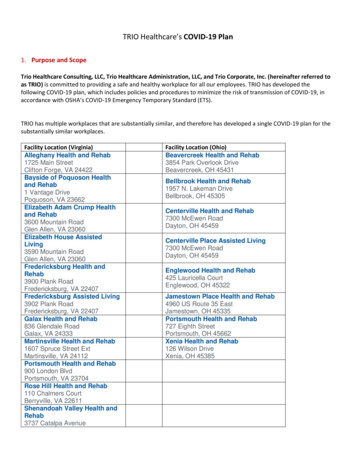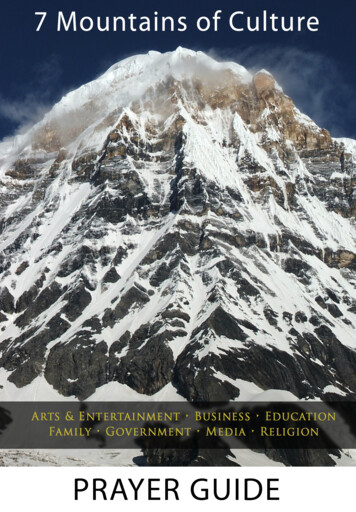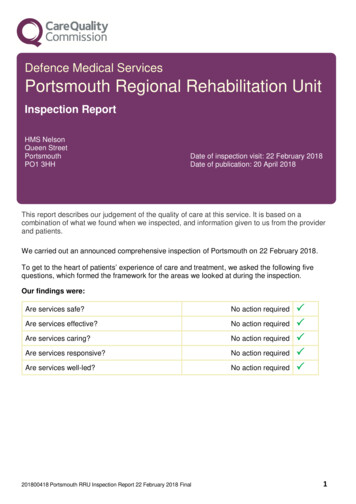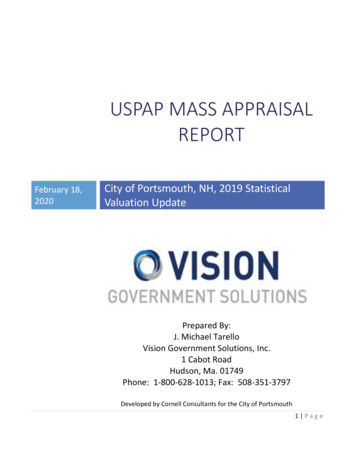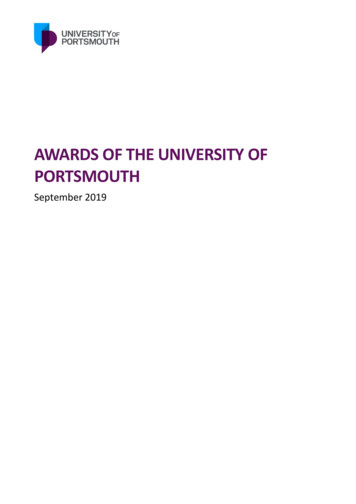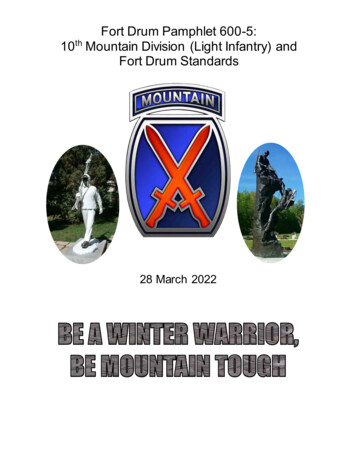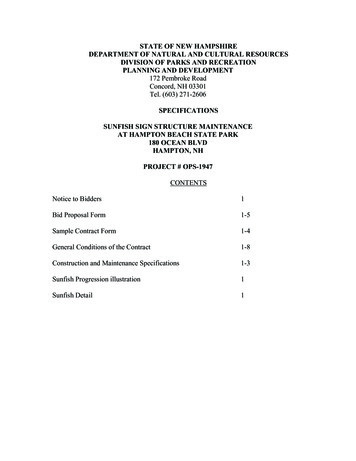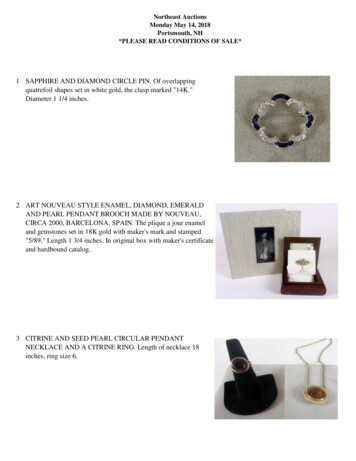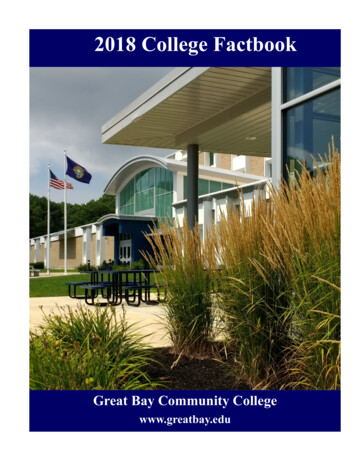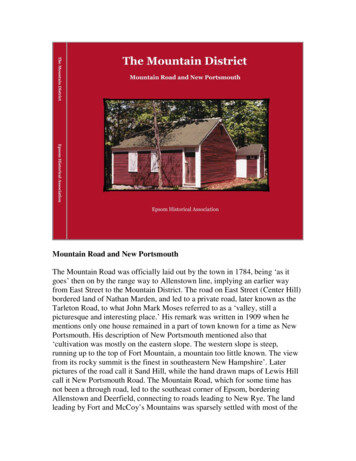
Transcription
Mountain Road and New PortsmouthThe Mountain Road was officially laid out by the town in 1784, being ‘as itgoes’ then on by the range way to Allenstown line, implying an earlier wayfrom East Street to the Mountain District. The road on East Street (Center Hill)bordered land of Nathan Marden, and led to a private road, later known as theTarleton Road, to what John Mark Moses referred to as a ‘valley, still apicturesque and interesting place.’ His remark was written in 1909 when hementions only one house remained in a part of town known for a time as NewPortsmouth. His description of New Portsmouth mentioned also that‘cultivation was mostly on the eastern slope. The western slope is steep,running up to the top of Fort Mountain, a mountain too little known. The viewfrom its rocky summit is the finest in southeastern New Hampshire’. Laterpictures of the road call it Sand Hill, while the hand drawn maps of Lewis Hillcall it New Portsmouth Road. The Mountain Road, which for some time hasnot been a through road, led to the southeast corner of Epsom, borderingAllenstown and Deerfield, connecting to roads leading to New Rye. The landleading by Fort and McCoy’s Mountains was sparsely settled with most of the
residents living at the higher elevation at New Portsmouth, and at the bottomwhich became the Mountain District.The area New Portsmouth and the Mountain District cover stretches from thesouth side of the home lots to the Allenstown/Epsom border and included lots 1through 20 in the first range, and the eastern end of lots 60 to 73 in the secondrange, those south of the Sanborn lot (the westerly side being part of New Rye).The town history in the Hurd’s Atlas by John Dolbeer lists the originalproprietors of these lots as the following: No. 1, Nathaniel White; 2, JamesSeavey; 3, John Odiorne; 4, Benjamin Ball; 5, Israel Mark; 6, Samuel Haines;7, John Foss; 8, Joshua Brackett; 9, Zachariah Foss; 10, Jonathan Dockam; 11,Richard Jordan; 12, Samuel Weeks; 13, John Underwood; 14, Robert Avery;15, John Rindge; 16, Richard Tarleton; 17, Henry Trefethen; 18, ThomasManneren; 19, John Wilson; 20, James Marden - 60, Daniel Lunt; 61, SampsonShiefe; 62, William Seavey Jun.; 63, Joseph Simpson; 64, Nehemiah Berry; 65,Joshua Seavey; 66, Samuel Brackett; 67, Robert Goss, Robert Goss, Jun; 68,Samuel Wallis; 69, Samuel Doust; 70, John Johnson; 71, James Chadwick; 72,Christopher Treadwick; 73, Richard Goss.Most of the original lots were never settled by their original proprietors, andfew, if any, had any settlements until after the French and Indian war. Themajority were populated after the American Revolution. Town records indicatea Southern District school as early as 1793, which would have served familiesin the New Rye and Mountain District, and it was known as early as 1804 asthe Mountain District School.Some of the families who lived in New Portsmouth and over the MountainRoad into the Mountain District are mentioned in articles by John Mark Moses(1908-1909), the memoirs of George H. Yeaton (1963), and a few notes byBenjamin Marden Towle (1936). The County maps of 1858 and 1892 show theoccupants of the homes, and additional names and locations can be found onthe hand drawn maps done by Lewis Hill about 1900. Hill’s maps contain themost names and locations of some of the earlier residents. Deed research,genealogy research and the aforementioned articles provide the basis forinformation contained in this book.The writings of George H. Yeaton in 1963 includes an article of the familiesand the area of New Portsmouth, called ‘The Ghost Town in Epsom’ of whichthe following is an excerpt:
THE GHOST TOWN IN EPSOM N.H. THE ALMOST FORGOTTEN PART OFTHE TOWNAND THE FAMILIES THAT LIVED IN THIS PART OF EPSOM, MANYYEARS AGOOn the old Canterbury Road and on what was once known as East Street, asyou came to the foot of the hill and at the place where Mrs. Isabella McCoywas captured on Aug. 21, 1747 by the Indians, one comes to the MountainRoad, this road which joins the Canterbury Road leads in a southerly directionand to what was at one time one of the most important sections of Epsom.This was the part of town known as “New Portsmouth,” a thrifty andprosperous community of farms and homes.There were one or more mills built on the mountain brook, and at one timetwenty to forty children came from this part of Epsom to attend the school atCenter Hill, four from New Portsmouth graduated from Dartmouth College,others studied and became professional men. In time of war men from thiscommunity left their home and families to fight for their country, one or morewere soldiers in the Revolutionary War, at least three served in the War of1812, and seven or eight were soldiers in the Civil War, the names of some ofthe families were Hall, Grant, Allen, Tarleton, Coffran, Dowst, Goss, Griffin,Foss, Babb, Wells, Langley, Appleton, Dickey, Hill, Nelson, and Joel Ames, theblacksmith.Tradition tells us that at one period in the early history of this settlement, therewere forty yoke of oxen kept on these farms. I was told by a descendant of oneof the old families, that when he, as a boy, went to school there were twentychildren who came from New Portsmouth to attend the school at Center Hill,this would be as late as the years 1873-1880.Some of the names used in referring to parts of this settlement were: The SandHill, Grants Hill, Allen Hill, Tarleton Meadows, Simeon’s Gully, MountainRoad, Tarleton or Grant Road and Mountain Brook; these were all familiarnames when referring to this section of Epsom, in the days long gone.Alter the close of the Civil War there were fifteen or twenty families living inthe New Portsmouth area but since that time the community has graduallygrown less and less until today April 1963 there are only three houses suitableto live in that are left standing, and only one of these are occupied, this one bya man and his wife both well advanced in years; their only livestock a dog anda few hens. It was in this part of Epsom that the Indians had a lead mine wherethey obtained the lead that they traded with Sargent Blake. (The location of the
lead mine is still a secret [1963]). The rest of this area, which was oncecovered with farms and homes is now dotted with old cellars, wells, springs,one Indian burying ground, one or more family burying grounds and smallclearings that were once large fertile fields, scattered in the valleys and on theslopes of Fort and McCoy's Mountains.The census of 1810 lists those enumerated as the home were visited, and givesa glimpse of the earliest families in New Portsmouth. Listed, they are DanielWells, Aaron Babb, John Grant, John Grant Jr., Simon Grant, Mark Emersonand Ephraim Amazeen. Nearer 1850, these larger tracts of land began to bedivided into smaller lots with additional families moving into the area. Familiesincluded were Simon, John and George W. Grant, Greenleaf Allen, Williamand Thomas Tarlton, Thomas Appleton, Charles Flower and Benjamin Hall. By1883 the Chesley family owned most of what was New Portsmouth, includingwhat were called th Tarlton farm and lot, the Grant Place, Allen Place, and HallPlace.JOHN GRANT FAMILYThe family of John Grant is nearly impossible to verify due to the lack of vitalrecords for the town of Epsom. There are few mentions of the family and a lackof information in war records. Two sources give a glimpse as to the names ofthe sons of John Grant and his wife Dorothy Foss.Poll and tax records would indicate there was only one Grant family in Epsom,and following the addition of names to the rolls, the following gives a pictureof the family:John Grant the father pays tax from 1793 until his death in 1822.Simon Grant is added in 1798William Grant in 1799 to 1811John Grant Jr. in 1803Job Grant in 1808 to 1809Thomas Grant in only 1818Ebenezer Grant in 1825Knowing the age at death of Simon and John Jr., and using the number of yearsbetween the addition of the Grants in the years of the polls, a sense of the yearsand order of the birth of the sons can be estimated. In 1810, the US Censustakers recorded their enumerations in the order in which they visited areahouseholds, and in that census, the Grants are listed one after the other, beingJohn, John Jr., Simon and William. Marriages show Simon marrying in 1798,
William in 1800, John Jr. in 1801, and Job about 1811. No marriage record hasbeen found for Thomas nor Ebenezer.A list of Epsom soldiers of the War of 1812 (John Dolbeer’s History in theMerrimack County Atlas) lists Thomas Grant, and it is known that the widowof Job Grant applied for a pension before she married a second time in 1816.John Grant Jr. also is not listed, though his grave is honored each year as aveteran of the 1812 War. William does not pay poll tax after 1811 and hiswidow appears with two children in the census of 1820, perhaps William also acasualty like his brother Job.John Grant’s widow in 1838 mentions in her will sons Simon, John andEbenezer, along with her three daughters. No record of Ebenezer has beenfound, but must have still been living at the time of his mother’s will. Thedaughters were Sally Libbey, Polly Foss, and Dorothy Goss. John Grant wasborn about 1755 in Newcastle, the son of Peter and Ruth (Seavey) Grant. Hismother was the daughter of William and Hannah Seavey, and a sister to EuniceSeavey. Samuel Davis was the son of Eunice and John Davis, and in hisstatement in support of a pension for John Grant, calls himself a relative. JohnGrant married Dorothy Foss, daughter of Job and Sarah (Lang) Foss, in Rye,April 20, 1775. Using town poll data and census data, with other records, thefamily was probably the following:Simon, born about 1776, died in Epsom, February 1863, married Hannah Babb,at least four children.William, born about 1777, died before 1820, married in Pembroke in 1800,Cata Hall, at least 2 unknown children. May have died in service during theWar of 1812 as he does not pay poll tax after 1811. Not mentioned in the willof his mother in 1838. Sally, married in Epsom in 1800, Joshua Libbey, had 9children and moved to Stanstead, Canada. John Jr., born about 1781, died inEpsom August 17, 1864, married at Epsom in 1801, Hannah McGaffey and hadthree children. His grave has a marker as veteran of the War of 1812.Polly, born about 1786, married in Epsom, Ephraim Blake Foss, son ofTimothy and Abigail (Blake) Foss of Barrington. Job, born about 1786, marriedNancy Locke about 1811, daughter of Deacon Abraham and Molly (Sanborn)Locke of Epsom. Probably died in service during the War of 1812 as his wifeapplied for a pension and married at Epsom in 1816, Andrew Fischer. Notmentioned in the will of his mother in 1838.Dolly, born about 1788, married about 1809 in Epsom, Nathan Goss, son ofSamuel and Abigail (Lucas) Goss. They had 10 children and resided in Epsom.Thomas, born about 1795, pays poll tax in Epsom up to 1818, and is probably
the Thomas Grant seen in listings as serving from Epsom in the War of 1812.Not mentioned in the will of his mother in 1838. Ebenezer, born about 1802,died after 1838 when he appears in the will of his mother, he pays poll inEpsom in 1825. Nothing more is known of him.The Grants lived for a time in Rye, then Greenland where most of his childrenwere probably born. John Grant is already of Epsom when he buys from Henryand Mary Prescott of Newcastle, 116 acres in lot 19, originally drawn by JohnWilson (in the deed as lot 17, but Wilson drew lot 19) in 1789. Interestingly,the same Henry Prescott bought in 1798, ‘the whole of the house lot formerlybelonging to Peter Grant of Newcastle, deceased’ from what would appear tobe heirs, though not specified. Peter had sold the ‘small house’ to WilliamGrant in 1771. Those selling included Bezaleel Hamblin of Portland and hiswife Ruth; Elizabeth Durgin and Mary Grant, both of Portsmouth, widow,possibly children of William; and Ruth Grant of Newcastle, widow, possiblythe wife of Peter Grant and mother to John.John Grant, cordwainer, settled his family on lot 19, of which he sold a portionto John Wells of Epsom in 1792, being 20 acres running from little meadowsbrook westerly to the second range. This lot would later be owned by his sonSimon. Most of the other land transactions are in the family, which speculateswhether there was any relationship to John Wells or his wife Jane. John’s sonJohn Jr. in fact names a son George Wells Grant.In 1802 John Grant deeds land to his son John Jr. who had married a yearearlier. The land was part of lot 19, again on the westerly side of a brook,running westerly to contain 40 acres, and a reverse deed quitclaims to his fatherrights for the term of his natural life. Part of the easterly end of the lot was soldby John Grant to John Wallace in 1804. In 1806 the family homestead isdeeded by father John Grant to his son Simon, who sells it back to his fatherSeptember 16, 1807. That same day, John Grant transfers ‘all the land I nowown, the same where I now live’ to John Grant Jr. and his brother Job, againwith rights to John and his wife Dolly during the term of their natural lives. Jobsells out his portion to Thomas D. Merrill in 1808, and Merrill sells the landback to John Grant Jr., in 1814.John Grant Jr. continues to buy parcels of land. His father died in 1822, and hisson John, via a lease in 1826, gives the use of one half of his real estate to hisson George W. Grant, allowing himself the use of the property during hisnatural life.
John Grant Jr. married at Epsom in 1801, Hannah McGaffey, daughter of Nealand Sarah (Babb) McGaffey. They resided on the homestead farm and hadthree children: Ruth Seavey, born in 1802 and married in 1822, Timothy Foss;George Wells Grant, born 1805 and married in 1827, Sally Foss, daughter ofTimothy and Abigail (Blake) Foss, who died in 1855; and Sarah Babb, whomarried a Daniel L. Richardson. John’s wife Hannah died in 1827 and hemarried second, about 1825, Betsey Phelps. They had a son Andrew McClaryGrant, born about 1823, and on his death record from Lansing, Michigan, hisparents are given as John and Betsy Grant, though census records wouldindicate he was also of the first marriage.John Grant in 1833 deed half of the homestead to his son George W., ‘easterlyon land of John Wallace, northerly on land of Mary Parker and GreenleafAllen, westerly by the Mountain Road, and southerly on land of WilliamTarlton.’ In 1841 he deeds to his son Andrew M. Grant ‘half my home farm,that is the farm and buildings where I now live, excepting what I haveconveyed to George W. Grant.’ Andrew deeds back to his parents in 1845 therights to the same property for the term of their natural lives. This changes in1849 when the same is deeded to his brother George W. Grant, making himsole owner of the family farm.George Wells Grant and his wife Sally Foss had four children: Emeline whomarried a John P. Stevens; William T., born in 1831 and married in 1856, SarahA. Twombly; Betsey F., of whom nothing more is known; and Clara S. whomarried in 1855, Perly C. Giles and resided on New Orchard Road. Andrew M.Grant married in 1842, Sally Cate Wiggin daughter of James Wiggin of Epsom,who died in 1846. He married at Concord in 1850, Nancy C. Morrill, and hadtwo children, Annie and Arthur. Nancy died in 1871, and Andrew married ashis third wife, a Lydia unknown. He died in Lansing, Michigan in 1911.George Wells Grant deeds the family homestead to his son William T. Grant in1853, still subject to the lease of its use by his father granted at the same.Various deeds are exchanged, and in 1857, Andrew quitclaims all rights to thehomestead back to his parents. His brother deeds his portion back to Andrew.John Grant died August 17, 1864, his second wife moved to Vermont to livewith a brother and died there in 1880, his first wife Hannah McGaffey died in1827. On November 1, 1864, Andrew sells the family homestead, 70 acres withbuildings to Charles E. Flower of Epsom, with 18 acres sold to Charles H. Hall.Charles E. Flower was a son of Charles Flower, of whose ancestry nothing isknown, and Hannah Lawrence, daughter of Joseph H. and Mary (Prescott)
Lawrence. They were married in Epsom in 1824. Charles E. married at Epsomin 1849, Susan M. Dow, daughter of Taylor and Abigail (Foss) Dow. Susandied in 1857 and Charles married her sister Mary A. Dow in 1858. Taylor Dowdied in 1839, and widow Abigail married Joseph Emerson of Epsom, whosefather Mark lived in New Portsmouth around 1810.Sometime between 1864 when Charles E. Flower purchased the Grant farm,and 1867 when he sold the property, deeds indicate that the Grant houses,apparently several residences on the farm, were lost to fire. Flower sold thefarm in two parcels. Both were sold October 22, 1867. The first parcel was soldto John Chesley, ‘on the westerly side of the highway leading from theMountain road to the Tarleton farm on the northerly line of said farm, runningwesterly on said line to land of Charles H. Hall.’ The second parcel was sold toMichael M. McClary, being ‘on the easterly side of the highway from theMountain road to the Tarlton farm.’ Both deeds reference the southeast cornerof the cellar of the Grant houses lately destroyed by fire.John Chesley’s portion was passed down through his family, and Michael M.Steele in 1882, sold his portion to John Chesley’s son, Daniel G. Chesley.SIMON GRANTSimon Grant was a son of John and Dorothy (Foss) Grant, born in Rye about1776. He moved to Epsom with his parents in 1789, and married in EpsomMarch 15, 1798, Hannah Babb, daughter of Philip and Grace (Lang) Babb. Hisfather sold part of lot 19, 20 acres, to John Wells in 1792, from the littlemeadows brook westerly to the second range. Wells sells half this lot in twoparcels, one of seven acres and the other of three acres, to Simon Grant in 1799.The other half was in the hands of Nathan Marden Jr., who sells his portion toSimon in 1802. Simon sells this land in 1804 to Thomas Babb, all 20 acres. Thehomestead farm was sold to Simon by his brother in 1806, and Simon sells itback to his father the next year. In 1814, his brother John Jr., sells Simon partof lot 19, all that part on the westerly side of the Mountain Road. This wouldappear to be where Simon made a home. Not much is known of the family ofSimon Grant, and most of his family is found through various deeds. Hischildren included a female, born about 1799; Levi T., of whom nothing isknown; Philip Babb, born about 1812, who married about 1832 in Lowell,Massachusetts, Mary Simpson; Eliza Bensin or Benson, who was born about1815 and married a James Simpson; and Aaron D., who married in Peterboro in1849, Sophia H. Snow, widow of Henry Swan, and after the death of Aaron,married third a John Wilder.
In 1832 Simon deeds the property he bought in 1814 to Levi T. Grant ofDunstable, MA., and Philip B. Grant of Lowell. Philip sells his undivided to hisbrother Aaron in 1838. Aaron D. Grant died before 1855, when his widowSophia sells the homestead ’20 acres on the westerly side of Mountain Road,part of lot 19 with the buildings thereon’ to Charles Henry Hall.Simon Grant in 1855 sells his half of the homestead to Mary Grant, wife of hisson Philip in 1855. She sells her half to Charles Henry Hall in 1856, makinghim sole owner of the Simon Grant farm. Hall leases the property to his fathershortly after buying the farm, and later sells it to his brother Daniel in 1862.The house is no longer standing.Uriah Hall owned land on Center Hill Road, near the junction with SanbornHill Road about 1825, sold by his heirs in 1865.BENJAMIN HALL FAMILYThe parents of Benjamin Hall were difficult to trace because of various sourcesrelating to where he was born. His son Daniel on his death record places it inTyngsboro, Massachusetts. The town records of his daughters Mary F.(Batchelder), Hannah (Roberts) and Ellen M. (Hill) give his place of birth asBrookline, New Hampshire. There is a reference that he was from England. Hisown New Hampshire death record gives Brookline, Massachusetts as his placeof birth, probably in error and should have been New Hampshire.
The Hall family is from Brookline, New Hampshire, originating from Bradford,Massachusetts. William Hall moved with his wife Mercy to Brookline, andamong his family was a son Uriah, born in 1778, and married in Brookline in1798, Hannah Shattuck. Their family included: Uriah, Mary, Nathan,Benjamin, George, Thurry and Abigail. Uriah married Olive Rand who wasborn in Epsom, daughter of Tobias T. and Mary S. Lear. Both Uriah andBenjamin above were coopers by trade and raised their families in Epsom, NH.Benjamin Hall first lived on Center Hill Road, as he bought a house and landthere in 1830 before moving to the Mountain Road. Uriah Hall owned land onCenter Hill Road, near the junction with Sanborn Hill Road about 1825, sold byhis heirs in 1865.Uriah, born in 1798, and Olive had children: William R., married SarahWyman and resided in Tyngsboro, MA.; Lemuel, who married Betsey C.Langley, daughter of True and Mehitable (Dow) Langley, resided in Epsom fora time in a house at New Portsmouth, died in 1866 and she married second,George H. Piper; Mary, who died unmarried in 1896; Uriah G. who marriedAddie Lamprey and resided in the Lakes region; Lucinda, who married JohnRobinson Dow; Sarah B., who married James P. Ordway and resided inHooksett; Elizabeth, married Alvin Libby of Maine; and Charles Walker,married Lorinda McIntire.Benjamin Hall, born in 1805, married in Epsom in 1829, Polly Wells, daughterof Daniel and Lucy (Emerson) Wells. Their children included: Charles Henry,born in 1831, and in 1851 married Lucy Jane Langley, daughter of True andMehitable (Dow) Langley, sister of Betsey C. Langley who married LemuelHall; Andrew J., born 1834, married, probably in Illinois, Sarah J. Poynter andresided for a time in the former Tarlton house in New Portsmouth; and Hollis,who was born in 1836 and died unmarried in 1854. Polly died in 1840, andBenjamin Hall married second, Mary Dowst, daughter of John and BetseyHolton (Wallace) Dowst in 1844. They had children: Lucy A., born 1846 andmarried Charles F. Cofran, two children, Shurldin and Malcolm W.; Daniel H.,born 1847, married in 1870 Hannah M. Piper, daughter of Gardiner W. andMariah H. (Dustin) Piper, one son, Benjamin Gardner Hall; Mary Frances born1850, married James Lewis Batchelder; Ellen M., born 1853, married in 1881,John J. Hill, children Carolyn, Mamie, Amy F.B., Lewis, Annie M., andRichard H.; Caroline, died young; Hannah M., born 1859 and married in 1877,Charles F. Roberts; and Edward, born 1862 and married Lucy Cofran. In 1856,Charles H. Hall, son of Benjamin and Polly, bought the Simon Grant farm andleased it to his father during his natural life, that he, Benjamin, keep in repair
the buildings and fences, as well as pay the taxes. Six years later Charles H.sells the property to his step brother, Daniel H. Hall. The property passed downthrough his heir, being his son Benjamin G., and through his heirs, remains inthe family. George H. Yeaton, in his memoir of the ‘Ghost Town of Epsom’written in 1963, adds the following: All that is left to show where the originalBenjamin Hall farm was, in the early days of the settlement of “NewPortsmouth,” is the house cellar partly filled. The remains of the foundationwhere the barn stood and the large lilac bush near the house cellar, in the smallclearing.CHARLES HENRY HALL HOUSECharles H. Hall was the son of Benjamin Hall and his first wife Polly Wells,who married in Epsom in 1851, Lucy Jane Langley, daughter of True andMehitable (Dow) Langley. The couple had seven children: Charlie, who diedyoung in 1864; Sarah Jane, born 1852 and married in 1873, Warren S.Bickford, son of Abraham and Nancy M. (Wells) Bickford; Henrietta who diedage 3 in 1858; Charles Anderson, born 1859 and died January 2, 1861; EllaEtta, married William B. Brown of Barrington in 1890; Hollis, born 1866 andmarried in 1891, Mabel L. Sanders of Epsom, daughter of William T. andDrusilla (Ewer) Sanders; and Charles Henry, born in 1871, and died age 21 in1893.Charles H. Hall bought land from Joseph Lawrence Jr. of Epsom on June 9,1852, where according to the deed his dwelling, barn and other buildings
already stood, a plot of four and a half acres. While Charles had built his houseon the small lot, he quickly accumulated additional property in the area. Theland was originally Marden land, which passed from James to Nathan Marden,the later selling the lot, number 20 in the first range, to James H. McClary,excepting a portion sold to Thomas Babb. McClary sold the property to his sonMichael, and upon his death the seized parcel was bought by Thomas D.Merrill in 1834. Sold by Merrill to David Griffin in 1839, it was next owned byJohn Griffin, his son in 1848 when it was sold to Joseph Lawrence. The deedwas for 80 acres, with Lawrence selling only 4 and a half acres to Charles H.Hall. The deed from Griffin to Lawrence gives the following description: Landin Epsom beginning on the Mountain road, so called at the southwesterlycorner of the farm formerly owned by Jonathan Chase, thence runningsoutherly by said road to the junction of the New Portsmouth road thence onsaid New Portsmouth road to land occupied by Greenleaf Allen, thence easterlyby said Allen land and land of John Grant and George W. Grant as the line ofsaid lot runs to a stake and stones at the corner of Nathan Griffin's land, thencenortherly by land of Nathan Griffin on a straight line to a stake and stones onthe southerly end of the home lots, thence westerly by land of Nathan Griffinand land of Jonathan Steele and the Chase farm, to bound first mentioned tocontain all the land within said bounds except 4 acres which I sold to NathanGriffin which is described by my deed to him, containing 80 acres.Charles Henry Hall wrote his will in 1898, and all the estate property passed tohis son Hollis Hall in 1904. Hollis died in 1938 and left his property to his onlyheir and daughter, Flora. Flora (Hall) Sullivan left her property to Blake'sBrook Campground, which sold the Charles H. Hall house to GottfriedZwesper in 1968.
Flora (Hall) Sullivan HouseHollis Hall built this house next to his father, Charles Henry Hall, cordwainer,shortly after he married Mabel Sanders in 1891. He inherited his fathers houseupon his death in 1904. Hollis and Mabel had one daughter, Flora D. Hall, whomarried in 1912, Arthur H. Sullivan, son of John F. and Martha O. Edmunds.Upon the death of her father Hollis, she inherited all the Hall family estate, andshe died in 1976. She was active and well known throughout Epsom, and wasinstrumental in starting the Epsom Historical Associations archive of photos.The house does not appear on the 1892 county map.The inventory of the estate included the home farm of 175 acres, the Appletonpasture of 8 acres, the Sanders pasture of 33 acres, the Cass pasture, 65 acres,the Sprout lot of 25 acres, and the Hall lot of 12 acres. By will the propertypassed to the Blake's Brook Campground, operated by John and Hilda Fulton.Fulton was the executor of Flora Sullivan's estate and sold two tracts of land,including the Flora Sullivan home, to Carole M. (Socha) Brown in 1977. Thehouse was bought by Carol A. Buckman in 1984.WELLS FAMILYInformation on this Wells family is very incomplete. There is a lack of recordsand deeds to establish many of the relationships, making some suppositionswhen trying to outline the family. There were in the New Rye area some earlydeeds between a Samuel and Simon Wells, and a John Wells sells land toEbenezer Wallace in the Mountain District in 1788, part of lot number 9. Thislot was sold by a Zachariah Foss to Jacob Libbey in 1741, and how John Wellsacquired it is unknown. The next deed seen was when John Wells bought 20acres of land from John Grant in New Portsmouth in 1792. In both instances,the sale to Wallace and the purchase from John Grant, John Wells is already ofEpsom.John Wells sells his 20 acres bought of John Grant to John Wells Junior in1796, the deed being signed by himself and wife Jane. It is possible that Janewas a sister of John Grant, but there is no proof. John Grant had a grandsonnamed George Wells Grant, and Lucy Wells, wife of Daniel Wells, was livingin 1850 in the household of Simon Grant. Again, this is supposition and notproved. John Grant paid poll tax in Epsom up to 1799, and does not appear inthe 1800 US Census, and apparently died between those dates. His wife Jane
may be the female over 45 in the household of John Wells Junior in 1800. Afew records of deaths were kept by the Congregational Church from 1815, andshe does not appear in them, so she may have died prior to 1815. The poll datashows a John Wells Junior paying tax on 30 acres of land starting in 1797, anda Daniel starts to pay poll tax in 1800, likely sons of John and Jane Wells.John Wells sold two parcels of land to Simon Grant in 1799, part of lot 19, atotal of 10 acres. He previously deeded to John Wells Junior in July of 1796, 20acres of lot 19, which he had purchased from Philip Babb. John Jr. sold half ofthe 20 acres to Nathan Marden Junior in November of that same year. The deedwas signed by John and Rebecca Wells. John Wells died in 1817, and thedisposition of his property remains unknown.Daniel Wells raised his family at New Portsmouth, buying land in 1814 fromMichael McClary, part of lot 20 in the first range to take its beginning at thecrotch of the New Portsmouth road where it crosses the Mountain road, then torun on the south side of the Mountain road as said road runs to lot numbered19, then of the line betwixt lot No. 19 to the New Portsmouth road, then on thenorthwesterly side of New Portsmouth road to the bounds first mentioned tocontain seven acres. This seven acre lot was sold by Daniel to his son Samuelon February 1, 1831, and sold it twenty days later to Thomas D. Merrill, beingthe same and all the land deeded to Thomas D. Merrill, being the same and allt
Mountain Road and New Portsmouth The Mountain Road was officially laid out by the town in 1784, being 'as it goes' then on by the range way to Allenstown line, implying an earlier way from East Street to the Mountain District. The road on East Street (Center Hill) bordered land of Nathan Marden, and led to a private road, later known as the
